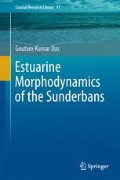Abstract
Sunderbans forms a part of the world’s largest fluvio-marine Ganges – Brahmaputra deltaic plain at the confluence of the Bay of Bengal with the largest block of halophytic mangrove forest. It has passed through a dynamic and complex physiographical and geomorphological history. Prograding in phases towards Bay of Bengal during Plio-Pleistocene inter-glacial period, it has left behind numerous distinctive landforms and islands of various shapes and sizes. The intricate network of rivers, tidal creeks and inlets with dynamic flow pattern accelerates the process of erosion and accretion and make the geomorphic set-up of the area a complex one. The important morphotypes of Sunderbans are beaches and inlets, creeks and estuaries, mudflats, coastal dunes, sand flats and mangrove swamps.
Access this chapter
Tax calculation will be finalised at checkout
Purchases are for personal use only
References
Alam M, Curray JR, Alam MM, Chowdhury MLR, Gani MR (2003) An overview of the sedimentary geology of the Bengal basin in relation to the regional tectonic framework and basin-fill history. Sediment Geol 155:179–208
Allison MA (1998) Geological framework and environmental status of the Ganges- Brahmaputra delta. J Coast Res 14(3):826–836
Anonymous (2003) A handbook on Sunderbans Biosphere Reserve. Ed. Director, SBR, Kolkata
Bagchi KG (ed) (1972) The Bhagirathi – Hooghly Basin. Calcutta University Publ., Calcutta
Banerjee M, Sen PK (1988) Paleobiology and environment of deposition of Holocene sediments of the Bengal Basin, India. In: Palaeoenvironment of East Asia from the mid- tertiary: proceedings of the second conference. Centre of Asian Studies, University of Hong Kong, Hong Kong, pp 703–731
Bhattacharya A (1993) Backwash and swash oriented current crescents: indicators of beach slope, current direction and environment. Sediment Geol 84:139–148
Bhattacharya A (1999) Embankments and their ecological impacts: a case study from the tropical low-lying coastal plains of the deltaic Sunderbans, India. In: Vollmer M, Grann H (eds) Large-scale constructions in coastal environments. Springer, Berlin, pp 171–180
Bilham R, England P (2001) Plateau ‘pop up’ in the great 1897 Assam earthquake. Nature 410:806–809
Biswas B (1963) Results of exploration for petroleum in the Western part of Bengal basin, India. Proc 2nd Symp Dev Ptr Res ECAFE Min Res Div Ser 18(1):241–250
Coleman JM (1969) Brahmaputra River: channel process on sedimentation. Sediment Petrol 3((2/3) Spl Issue):129–139
Curray JR (1991) Geological history of the Bengal geosynclines. J Assoc Explor Geophys XII:209–219
Das GK (2006) Sunderbans-environment and ecosystem. Levant, Kolkata
Das GK (2009) Beach processes of Tidal Islands of Hugli Estuary, West Bengal. Geogr Rev India 71(3):240–248
Das GK, Bhattacharya A (2002) Dynamic geomorphic environment of Indian Sunderbans. In: Basu SR (ed) Changing environmental scenario of the Indian sub-continent. ACB Publication, Kolkata, pp 284–298
Davies JL (1964) A morphogenetic approach to world shoreline. Zeits Fur Geomorph 8:127–142
Davies JL (1972) Geographical variation in coastal development. Oliver & Boyd, Edinburg
De Boer PL, Oost AP, Visser MJ (1989) The diurnal inequality of the tide as parameter for recognizing tidal influences. J Sediment Petrol 59:912–921
Flemming BW, Fricke AH (1983) Beach and nearshore habitat as a function of internal geometry, primary sedimentary structures and grain size. In: McLachlann A, Erasmus T (eds) Sandy beaches as ecosystems. Dr. W. Junk Publ., The Hague
Galloway WE (1975) Process framework for describing the morphologic and stratigraphic evolution of deltaic depositional systems. In: Broussard ML (ed) Deltas, models for exploration. Houston Geological Society, Houston, pp 87–99
Ginsberg SS, Perillo GME (2004) Characteristics of tidal channels in a mesotidal estuary of Argentina. J Coast Res 20(2):489–497
Harms JC, Fahenstock RK (1965) Stratification, Bed forms and flow phenomena with an example of Rio grade in Primary Sedimentary Structures and their hydrodynamic interpretation, S.E.M.M. Spec. publ. 12., pp 84–115
Inman DL, Nordstrom CE (1971) On the tectonic and morphologic classification of coasts. J Geol 79:1–21
IPCC (2007) Climate change-2007. Impacts, adaptations and vulnerability. Contribution of working group II to the fourth assessment report of the Intergovernmental Panel on Climate Change. Cambridge University Press, Cambridge
Komar PD (1976) Beach process and sedimentation. Prentice Hall Inc, Englewood Cliffs
Kuehl SL, Levy BM, Moore WS, Allison MA (1997) Subaqueous delta of the Ganges- Brahmaputra river system. Mar Geol 144:81–96
Morgan JP (ed) (1970) Deltaic sedimentation: modern and ancient. Special Publication Society of Economic Paleontologists and Mineralogists 15, Society of Economic Paleontologists and Mineralogists, Tulsa, 312p
Sengupta S (1966) Geological and geophysical studies in the western part of Bengal basin, India. Am Assoc Petrol Geol Bull 50:1001–1017
Sengupta S (1972) Geological framework of the Bhagirathi-Hugli Basin. The Bhagirathi-Hugli Basin proceedings of the inter disciplinary symposium. Calcutta University Publications, Calcutta, pp 3–8
Sharma AP (2010) Coastal zone vegetation in India with reference to mangroves and need for their conservation. In Sunderbans: issues and threats. CIFRI (ICAR), Kolkata, pp 9–40
Sikdar AM, Alam MM (2003) 2-D modeling of the anticlinical structures and structural development of the eastern fold belt of the Bengal basin, Bangladesh. Sediment Geol 155:179–208
Umitsu M (1993) Late Quaternary sedimentary environments and landforms in the Ganges delta. Sediment Geol 83:164–178
Umitsu M (1997) Landforms and floods in the Ganges delta and coastal lowland of Bangladesh. Mar Geol 20(1):76–87
Vannucci M (1989) The mangroves and us; a synthesis of insights. Indian Association for the Advancement of Science, New Delhi
Wright ID, Short AD (1982) Morphodynamics of beaches and surfaces in Australia. In: Komar PD (ed) Hand book Coastal processes and erosions. CRC Press, Washington, DC
Author information
Authors and Affiliations
Rights and permissions
Copyright information
© 2015 Springer International Publishing Switzerland
About this chapter
Cite this chapter
Das, G.K. (2015). Sunderbans: Physical Aspects and Configurations. In: Estuarine Morphodynamics of the Sunderbans. Coastal Research Library, vol 11. Springer, Cham. https://doi.org/10.1007/978-3-319-11343-2_1
Download citation
DOI: https://doi.org/10.1007/978-3-319-11343-2_1
Published:
Publisher Name: Springer, Cham
Print ISBN: 978-3-319-11342-5
Online ISBN: 978-3-319-11343-2
eBook Packages: Earth and Environmental ScienceEarth and Environmental Science (R0)

